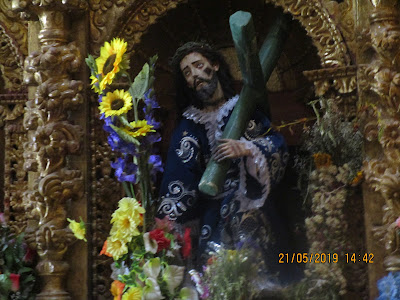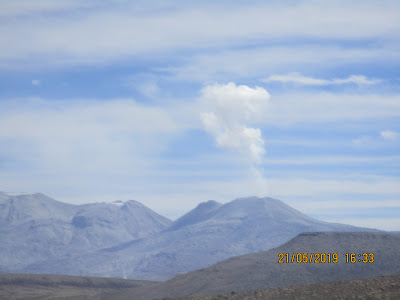Locals chew coca leaves as a remedy for altitude sickness. Alternatively, and more palatable, is mate de coca, tea made from the leaves, which can alleviate the symptoms of altitude sickness, It didn't seem to work for me. In the Colca Valley region coca is a sacred plant and a strong cultural symbol. To help ensure a successful harvest locals perform a challaco ritual which involves the sprinkling of food, a purple corn drink, chicha morada, and coca leaves as a gift to the goddess Pachamama, or Mother Earth.
The Colca Valley is covered with pre-Inca farming terraces where potatoes, quinoa and corn continue to be cultivated. We passed many where quinoa was growing and Henry told us that the people use the leaves of the quinoa crop like spinach.
En route we stopped for a few minutes to admire llamas and alpacas and to admire the beautiful textiles being sold by local vendors.
Not a lot of water in the Colca river.
We passed through Maca village and saw this beautiful church and this statue. Seemingly it is a scene from a local dance where the wife carries her husband. I have no idea why he is wearing a mask. We returned to Maca later.
Pre-Inca terraces made over 1800 years ago. Today they plant many types of potatoes, all sizes, all shapes and all purposes. There are fertility potatoes and contraceptive potatoes. There are even poison potatoes to deal with the enemy. In Inca times it was mainly potatoes and corn - there are more types of corn than in Mexico. When the Spanish arrived they added wheat and barley. They also grow alfalfa, beans of all sorts and quinoa.
Prickly pear cactus
This was the entrance to a 400 m tunnel. The passengers were rather unruly!
At the beginning of the Colca Canyon the bus stopped and everyone, except me, got out for a hike. I took advantage of the bus being stopped to go to the onboard loo. The bus driver pointed out the condors to me. They were quite far away but I knew we would see them up closer when the others came back.
These are all photos Jim took during the hike which he says was quite tough over very uneven ground. I doubt if my balance would have coped with it if I hadn't altitude problems.
Cow skulls along the rim of Colca Canyon seen during the hike.
The group, minus me, taken at a viewing point during their hike.
The Colca Canyon is twice as deep as the Grand Canyon but its walls are not as vertical. we made our way to Cruz del Condor to watch the condors. Our delight in them was fuelled by Jolanda, our guide for the area, speculating that they might not grace us with their presence.
Andean condors are massive birds measuring more than 3 metres in wingspan and weighing up to 33 lbs. They use thermal uplifts from the canyon to soar and can fly for hours without using their wings. They can spot animal carcasses from miles away.Andean condors can live for 80 years. They were considered sacred by the Incas. Females have babies every 2 years. Babies can't fly until 7 months and then they jump. Not all eggs become babies, only about half of them. Nests are holes in the in the mountain. If an egg seems empty the condors eat it. Condors are mostly black but males have a white collar around their necks and some white markings on their wings. Juvenile condors are a brown colour. It takes condors only 2 hours from Colca Canyon to the coast. They don't eat every day but when they are really hungry they will kill animals. They are a protected species.
They were much more impressive than these photos show.
Condors are monogamous and mate for life. Seemingly when the condor's life partner dies the widowed bird, in grief, plummets to its own feathery death in the canyon - a tragic bird version of Romeo and Juliet!
The Cross of the Condors. While we were here there was an earth tremor which neither Jim nor I noticed. Sarah and Charlotte and most of the group did feel it. According to them it caused a slight landslide at the canyon and there was a significantly greater number of condors flying after it.
A rather strained smile from me that does not mask how awful I was feeling.
Anywhere there is a viewpoint there are local vendors.
At this stage - and it was still only morning and we had seen so much - we started to make our way back to Chivay where we would drop Jolanda off. The landscape was very interesting, lined with Inca terraces along the mountain slopes looking down on the Colca river which created the Colca Canyon.
We stopped off in Maca to taste prickly pear juice. Jim had his with some pisco in it. Prickly pear juice tastes a bit like kiwi fruit.
Prickly pears.
Inside the Church there is a huge amount of gold. The mirrors seem to provide illumination
 |
| Add caption |
Back in Chivay we dropped Jolanda off and then went back to the roadside cafe at Yura where we had more Inca tea and a lunch of chicken and avocado sandwich which was delicious. We stopped again an hour and a quarter later to enjoy the beautiful scenery at a small lake, Lagunillas.
This is an orphanage outside Chivay. It has thatched roofs and looks very well kept.
Misti was spewing white smoke.
An earth tremor and an active smoking volcano on the same morning! Not to mention the giant condors!!
Little grottos are a widespread feature of Peru. Some of them mark places of death.
There was a lot of traffic in what Henry called the "crazy city" - Juliaca. Seemingly it is the centre of the cocaine smuggling business.
Then it was on to Puno, the capital of the southeastern region with the same name. Puno is one of the highest cities in Peru and is a port on Lake Titicaca. Puno was declared the capital of Peruvian folklore because it has more than 350 dances. Later in the evening we went a few doors up the street to Balcones de Puno for dinner and traditional entertainment.
On arrival in Puno we had a short walk uphill to our accommodation which nearly killed me. I really believed that I couldn't continue on but then I realised that I couldn't go home as there were homelinkers in the house. After a bit of a cry and a shower I gathered myself together again and we set off for Balcones de Puno. The music and dance was very good I thought but for some reason our group did not pay much attention.
There were several dances using handkerchiefs. I think the dance is called Marinera de Puneno.
This was Danza de la Diablada (Dance of the Devil). The theme of this dance is the constant struggle between good and evil. Costumes in the Puno dancing are fantastically elaborate made with gold and silver embroidery, precious stones and rich fabric. The masks represent animals, demons and angels recreating great fantasies of Puno folklore.
I was a bit surprised by the short skirts but seemingly that is not unusual. This dance was called Morenada. The traditional head gear for this is a hat with a long feather.
During the performance we all got distracted by Lotte who was crying. Sarah took her outside and had a long chat with her. I'm not sure it really helped as she continued to cry when she came back and eventually had to go back to the hotel. Meanwhile we had our meal - I had a bean salad but was not able to eat much of it. When we got back to the hotel I had to reorganise our packing as we were going to our homestay the next day and could bring very little. It was quite a feat to do this as space in the room was very restricted. I barely slept and when I did I was woken by cramps in my legs.





































































































































No comments:
Post a Comment